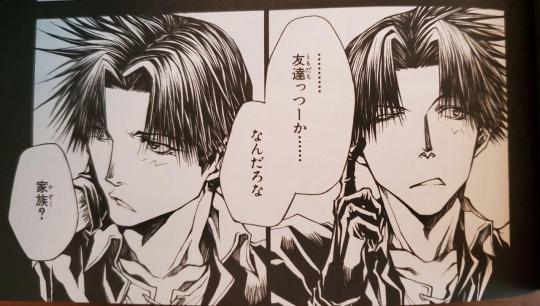#and the featured relationships in both emphasize emotional connection/intimacy WAY more than physical contact
Text
thinking today about my confusion on how to accurately describe my feelings for shigure and dimitri like wait... i’ve seen this before...

oh yeah!!
#'friends? uhh... or maybe you'd call it... family?'#listen there's a reason my tagline contains 'everything i do is ultimately rooted in wild adapter'#i realized it makes sense because this and no. 6 were my first major exposures to lgbtq+ relationships growing up#and the featured relationships in both emphasize emotional connection/intimacy WAY more than physical contact#add that to my mix of childhood trauma connected to physical touch#and BOOM suddenly i understand why my my major hangups with anything labeled 'romantic' is with physical contact#and obviously popular media and the way society labels/categorizes/codes things is supremely unhelpful#and how it's like THIS is what a romantic relationship is SUPPOSED to look like!#to the point that when you start having all of these caveats or conditions you wonder if it should still 'count'#rereading the way this is resolved in wa actually made me feel a bit better too#because society DOES have all of these labels and categories but#they're more or less arbitrary ways to fit things into boxes#and even without all of those labels and categories#the relationship or other thing in question still exists on its own unchanged in spite of everything#so yeah having labels is NICE but if it's just gonna stress you out finding the right one#then you don't NEED to use any of the ones society tries to give you#honestly i just appreciate wild adapter more and more as i get older for things like this
0 notes
Text
Intimacy and Her
Hello readers! As we have transitioned into this new section for the semester, this week as a class, we took time to explore the topics of intimacy and how it relates to our socially dominated technology devices. The assigned readings for the week consist of “Love Messaging” authored by Sunil Manghani and “Love in the Time of Tamagotchi” by Dominic Pettman. Both articles discuss how intimacy has changed with our technologically advanced society, with topics that include an embodiment of digital relationships, Meru tomos, and tanka poetry. To correlate these two articles with a modern illustration, the class and I analyzed the film Her (2013) which is written, directed, and produced by Spike Jonze. The story takes place in Los Angeles in the near future surrounding the protagonist, Theodore who is struggling to move on after separating from his wife while finding a new love with an operating system named Samantha.
In Pettman’s research, he discusses how love and intimacy should be considered as digital because of our communication when one responds to another. For example, “yes, no, loves me, and loves me not” are all forms of codes to use when speaking to a lover. He conveys that it should not be overlooked as humans and machines communicating but as “lovable or unlovable” (Pettman, 2009, pg. 192). Pettman then begins to discuss how in more recent years, the technology that we possess as a society has allowed for more experiences such as building relationships solely online and with a lack of embodiment. One of the advantages of this new frontier of dating is that it “allows an escape from the restrictive conditions of an actual experience... the absence of things like eye contact actually liberates a person” (Pettman, 2009, pg. 194). The sense of touch and face-to-face (F2F) experience is not apparent when an individual decides to be a relationship and online persona.
The last concept that Pettman examines is the term Meru tomos, which is translated as “mail friends”. Meru tomos are an example of libidinal relationships that demonstrate how the lack of embodiment is becoming widely popular with new forms of media. Pettman discusses that young Japanese people have integrated these mail friends more systematically into their lives. Meru tomos are usually the recipients of text messages as the channel “in an anonymous network of friends-of-friends-of-friends” (Pettman, 2009, pg. 193). This paradox that users develop is that the more Meru tomos that they have on their phones, the more friends that they have, which leads to the question if those friends can be considered as true friends? One researcher that Pettman examines is from Zygmunt Bauman as he explains that “proximity no longer requires physical closeness, but physical closeness no longer determines proximity” (Pettman, 2009, pg. 193). This concept is really startling because of the new age of technology that our society is creating no longer needs physical touch to build relationships.
During the film Her, Theodore is struggling to deal with the heartbreak from his ex-wife and loneliness that develops as he realizes that he does not have a significant other to share his life with. As he first meets Samantha, she is portrayed as a companion that assists him throughout his days. For example, she would proofread the letters that he composes for work and organize his emails to declutter his hard drive. As Theodore becomes more comfortable with Samantha as his operating system, he gets the courage to venture on a blind date that has the same mutual friends. When the date is coming to an end, things become more physical and Theodore constantly gets critique on how to kiss and his maturity as Olivia Wilde’s character says that she can’t let Theodore waste her time if he is not able to be serious. Soon after, Theodore goes back to talking to Samantha and because of this moment, he and Samantha begin to disclose more information and emotions toward each other. This leads to Theodore and Samantha starting a relationship that is solely online.
Pettman’s argument resonates with this film and this scene in particular with the concept of Meru tomos and the lack of embodiment. Because Theodore is not able to look directly into Samantha’s eyes, he is able to disclose more freely than he would have with Olivia Wilde’s character. This is Theodore's idea of escapism and throughout the film, he believes that Samantha is truly a human being, although in our class we disputed about this claim. I also believe that for Theodore, being in love with an operating system is utilizing the convenience of not having to monitor nonverbal behaviors in front of Samantha and the fact that he is able to talk to her whenever he desires to because she exists on his system. Although Samantha is shown throughout the film calling him to remind him events or important notifications, he is able to ignore her at any point in time.
From the article by Manghani, she explores the art of love messaging with the technology that mobile phones offer. She begins by stating that text messaging was never meant to be a prominent feature on our mobile phones but because of our culture it has become a deep necessity for all users. Text messaging is simply a literary form that “is not to be located in the words and letters...but in their manipulation (and absence)” (Manghani, 2009, pg. 211). She draws a connection with tanka poetry and text messaging but does not want to make a clear comparison. Tanka poetry is originated in Japan that consists of 31 characters, usually in the form of 5-7-5-7-7 characters. There is a belief that everybody is capable of composing poetry which Manghani likes to correlate with text messaging because tanka poems tend to be more lyrical and express emotions in a variety of ways. Text messaging is viewed as a tool to help users develop and manage romantic relationships without the F2F situations that could alter their nonverbal behaviors such as with awkwardness.
To connect this piece to the film Her, Theodore and Samantha are now communicating with each other as lovers and companions. One scene that touches on the concept of love messages is when Samantha wakes Theodore up in the middle of the night just to communicate with him that she loves him. She simply utters “I love you” after not being able to talk to Theodore and she got into a fight about her existence and role in his life. I think this emphasizes the importance that messages like text and tanka play in relationships. Because the simplest of phrases can contain so much weight in a romantic relationship. Manghani explains that although text messages have less to offer in terms of “high” wordplay, there is an importance that should be recognized in the timing and space of words. This form of communication is just another option in which lovers are able to enhance their communication with one another. The art of Tanka and text messages both require a level of trust and understanding and in Samantha’s case, I believe that she utilized her time and words wisely when communicating her emotions towards Theodore. If she would have communicated with him more on a different subject, the importance of the message would not have been received well as it was in the middle of the night. I think that they both wanted to hear those words of love from each other and it was wise that Samantha kept her message short and filled with meaning, just like a tanka poem.
The film Her offers great discussion points about Theodore and Samantha’s use of messaging between each other and if a physical body is necessary to build a relationship. The idea of these two concepts at a first glance sounds absurd, but after watching the film multiple times, Spike Jonze understands that this future can and is in some cases a reality for some individuals. Jonze did an incredible job creating a story that talks about these concepts and issues while surrounding it with a beautiful love story. At first, my opinions that Theodore and Samantha’s relationship was not real because my stance was that physical touch is something that every human being needs to survive. However, after reading Pettman’s article, I’m conflicted on where I stand concerning this subject. Because one of Pettman’s argument is that the lack of embodiment allows individuals to express themselves more freely because their F2F interactions are nonexistent. And this argument makes sense because of how our society is conforming to building relationships in the second decade of the 21st century with apps like Tinder and EHarmony. Forming these relationships online creates an escape for users to express themselves more freely. I believe that the film Her really brings to life what has been occurring for a while in our society with individuals building relationships. In conclusion, it amazes me that our cultural norms are turning towards these standards of romantic relationships with the lack of embodiment and it is intriguing how as a society, our forms of communication resemble those of ancient times like tanka poetry.


0 notes